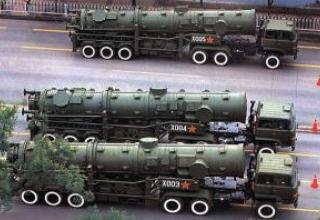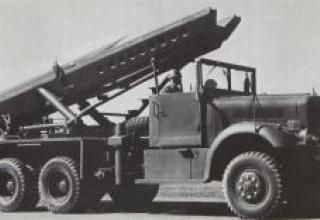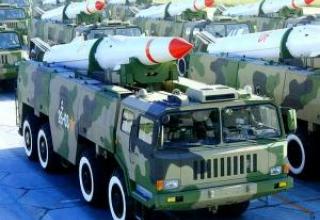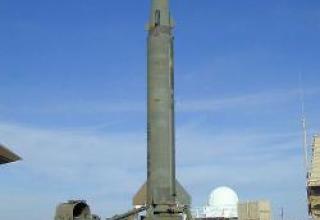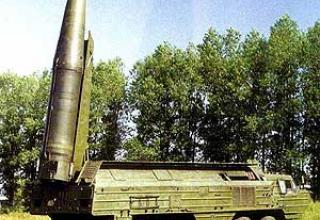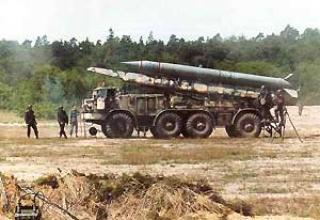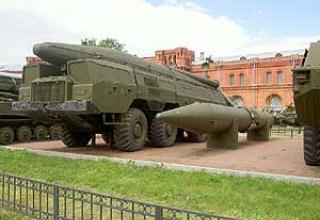The 9K720 Iskander high-precision operational and tactical missile system of the Ground Forces is designed for covert preparation and effective missile strikes on especially important small and surface targets at the depth of the enemy's forces operational structure: firing facilities (missile systems, radar, long-range artillery), aircraft and helicopters at airfields, command and communication points, the most important objects of civil infrastructure.
The 9K720 ATC was created as a result of the joint work of a group of research institutes, design bureau and factories under the leadership of the Kolomna Engineering Design Bureau (KBM), known as the Tochka and Oka missile systems manufacturer. The launcher is designed by the Central Design Bureau "Titan" (Volgograd), the homing system - by the Central Research Institute of Automation and Hydraulics (Moscow).
Under the conditions of the 1987 DSMD Treaty and the renunciation of the use of nuclear weapons on the TVD, a number of fundamentally new requirements are imposed on modern tactical complexes:
- to use only non-nuclear means of destruction;
- ensuring precision firing accuracy;
- control of the entire flight path;
- a wide range of effective combat equipment;
- availability of a combat control automation system and information support system in the complex, including preparation of reference information for correction and final guidance systems;
- possibility of integration with global satellite navigation systems (GSSN - "Glonass", "NAVSTAR");
- possibility of hitting highly protected targets;
- increased fire productivity;
- ability to effectively overcome the effects of air defense and missile defense means;
- ability to defeat moving targets.
To meet the above requirements, an export version of the 9K720 OTRK has been created, which is designated "Iskander-E". "Iskander-E" absorbed the best scientific, technical and design achievements in the field of operational-tactical missile systems and a set of implemented technical solutions, high combat efficiency is a weapon of a completely new generation, superior in its tactical and technical characteristics of the existing RK 9K72 "Elbrus", "Tochka-U", "Lance", "ATASMV", "Pluton", etc.
The main features of RK 9K720 "Iskander":
- Highly precise and effective defeat of various types of targets;
- capability for covert training, combat duty and effective missile strikes;
- automatic calculation and input of a missile flight mission by means of a launcher;
- high probability of performing a combat mission in conditions of active counteraction by the enemy;
- high probability of non-failure operation of the missile in preparation for launch as well as in flight;
- high tactical maneuverability due to high cross-country ability of combat vehicles mounted on all-wheel drive landing gear,
- strategic mobility through the transportability of vehicles by all modes of transport, including transport aviation;
- automation of combat control of missile units,
- operational processing and delivery of intelligence to the appropriate levels of management;
- long service life and ease of use.
"Iskander-E is fully compliant with the Missile Technology Nonproliferation Control Regime by its tactical and technical characteristics. These are "deterrent weapons" in local conflicts, while for countries with limited living space they are strategic weapons. The structure of the complex, its control system, automated combat control and information support allow the complex to promptly respond to new requirements without significantly improving its combat facilities and, as a result, guarantee a long life cycle.
For the Russian Army, a version of the Iskander-M missile system with an extended range (more than 450 km) and Iskander-K equipped with a high-precision cruise missile R-500 (range up to 2600 km) of the Caliber system developed by the Yekaterinburg Design Bureau Novator was developed. The complex was successfully tested in 2007 at Kapustin Yar proving ground.
In 2007, Iskander-M complexes (four combat vehicles) were equipped with a training division in Kapustin Yar, which took part in the war with Georgia in August 2008.
In the west, the complex was designated SS-26.
Composition:
The complex consists of:
- missile 9M723;
- 9P78 self-propelled launcher (SPS);
- transport and charging machine 9T250 (TZM);
- command and staff vehicle 9C552 (KShM);
- mobile information preparation station 9C920 (PPI);
- Regulation and Maintenance Machine (MRTO);
- life support machine;
- sets of arsenal and training equipment.
The 9M723 is a solid fuel, single-stage missile with a head part not separated in flight. The missile is controlled on the entire flight path by means of aerodynamic and gas-dynamic rudders. The flight path of 9M723 is not ballistic but controllable. The missile constantly changes the plane of the trajectory. It is particularly active in maneuvering at its acceleration and approach to the target - with an overload of 20 to 30g. In order to intercept the 9M723 missile, the missile must move along a trajectory with an overload two to three times higher, which is almost impossible. Most of the missile's trajectory, manufactured using Stealth technology and having a small reflective surface, passes at an altitude of 50 km, which also significantly reduces the probability of its defeat by the enemy. The 'invisibility' effect is achieved by combining the missile's design features with special coatings.
The missile is brought directly to its target by an inertial control system and then captured by an autonomous correlation-extreme homing optical head (see photo). The principle of operation of the homing system OTR 9M723 is that the optical equipment generates an image of the terrain in the target area, which is compared by the on-board computer with the standard introduced during the preparation of the missile for launch. The optical head is highly resistant to existing means of electronic warfare and allows successful missile launches even on moonless nights when there is no additional natural illumination of the target, hitting the target with an accuracy of plus or minus two meters. No other tactical system in the world can accomplish such a task except Iskander. In addition, optical systems do not need signals from space radio navigation systems, which can be switched off or disabled by radio interference in crisis cases. Combining inertial control with satellite navigation equipment and optical CNS makes it possible to create a missile that hits a given target in almost every conceivable condition. The homing head can also be used on ballistic and cruise missiles of various classes and types.
The missile can be equipped with various combat units (10 types in total), including:
- a cluster warhead with shrapnel-type non-contact detonation warheads;
- a cluster munition with cumulative shrapnel warheads;
- a cluster munition with self-manufacturing warheads; a cluster munition with self-manufacturing warheads;
- a cluster munition with a volume detonation capability;
- shrapnel-flagged warhead (SRFF);
- high-explosive high-explosive warhead;
- penetrating combat unit (IBU).
A cassette warfare unit shall provide opening at an altitude of 0.9-1.4km with further separation and stabilization of combat elements. The combat elements are equipped with radio sensors and the detonation of combat elements is performed at an altitude of 6-10 m above the target.
Due to the implementation of terminal control and guidance methods, control over the entire flight path, a wide range of powerful combat units, and ensuring that the airborne DS is combined with various correction and homing systems, as well as a high probability of performing a combat mission in conditions of active counteraction by the enemy, standard targets are hit by the launch of only 1-2 Iskander-E missiles, which is equivalent in effectiveness to the use of nuclear warheads.
Fully self-contained LTP is located on an 8x8 wheeled chassis of cross-country ability (MZKT-7930) and is designed to store and transport missiles, prepare for launch and launch within the firing sector ± 90 ° with respect to the direction of arrival of LTP. LSU provides: automatic determination of its coordinates, data exchange with all control elements, combat duty and preparation for launch with the missile in a horizontal position, single and multiple launch of missiles, storage and verification of missiles. The most important feature of the launcher was the placement of two missiles on it, rather than one (as in Tochka and Oka). Location time of the launcher on the starting position is minimal and is up to 20 minutes, with the interval between the launches of the 1st and 2nd missiles no longer than one minute. The missiles do not require specially prepared engineering and topogetic launch positions, which may lead to their disclosure by the enemy. Launches can be carried out from the so-called "march readiness", i.e. the launcher enters any site (except marshy terrain and loose sand) and its calculation in an automated cycle, without leaving the cockpit carries out the preparation and launch of the missile. The launcher then moves to the reload point and, after loading the missiles, is ready to deliver a second missile strike from any starting position.
TZM is also placed on MZKT-7930 chassis and equipped with a boom crane. Gross combat weight - 40000 kg, TZM calculation - 2 persons.
The automated control system is based on the KAMAZ chassis, which is unified for all levels of command and staff vehicle control. Adjustment to a certain control level (brigade, division, starting battery) is carried out programmatically during operation. To ensure information exchange, combat control and communication equipment is placed in the launch vehicle. Information exchange can be carried out both via open and closed communication channels.
"Iskander-E is integrated with various intelligence and control systems. Information about the object of destruction is transmitted from a satellite, a reconnaissance aircraft or an unmanned aerial vehicle (of the Flight-D type) to an information preparation centre. It calculates the flight mission for the missile and prepares the reference information for the missiles with OGSN, then on the radio channels this information is transmitted to the command and staff vehicles (KSM) of division commanders and batteries, and from there - to the launchers. The missile launch teams can be formed either at the KShM or by the senior artillery command posts.
The machine of regulation and maintenance (MRTO) is placed on the chassis of "Kamaz" family and is intended for routine inspection of onboard equipment of rockets, placed on TZM (as well as in containers), inspection of devices, included in group sets of ZIP elements of the complex and current repair of rockets by MRTO calculation forces. The weight of the machine - 13500kg, time of deployment - 20min., time of the automated cycle of routine inspection of onboard equipment of the rocket - 18min., calculation - 2 people.
Life support vehicle is designed to accommodate combat calculations (up to 8 people) for rest and meals.
Characteristics:
| Range of fire, km: - minimum - maximum |
50 280 (400) |
| Shooting accuracy (KVO), m: - without homing - homing system |
30-70 5-7 |
| Number of missiles: - at the LPU - on the TZM |
2 2 |
| Launch time of the first rocket, mines: - on high alert - on the march |
not more than 4 not more than 16 |
| Interval between launches, min | up to 1 |
| Assigned service life, years | 10 (of which 3 years in the field) |
| Temperature range of application, ° C | up to ± 50 |
| Altitude above sea level, m | up to 3000 |
| Rocket | |
| Missile launch weight, kg | 3800 |
| Weight of combat unit, kg | 480 |
| Length, mm | 7200 |
| Maximum diameter, mm : - on the rope clamps - at the engine level |
950 920 |
| SPU | |
| Gross mass, t | 42 |
| Weight of the load to be placed, t | 19 |
| Maximum speed, km/h: - on the highway - dirt road |
70 40 |
| Test fuel consumption reserve, km | 1000 |
| Calculation, man. | 3 |
| KSHM | |
| Number of automated workplaces, pcs. | 4 |
| Maximum range of radio communication, km - at the parking lot - on the march |
350 50 |
| The time of calculation of the combat mission, s | up to 10 |
| Maximum command transmission time, s | 15 |
| Number of communication channels | up to 16 |
| Data transmission (reception) rate, kbps | 16 |
| Deployment/cooling time (with antennas deployed/cooled), mines | up to 30 |
| Continuous operating time, h | 48 |
| PPI | |
| Number of automated workplaces, pcs. | 2 |
| Time to determine the coordinates of the target point, mines | between 0.5 and 2 |
| Time to bring the target designation to the SDA, mines | 1 |
| Continuous operating time, h | 16 |
Testing:
The combat operation of the complex and the functioning of its facilities in the process of firing are as follows.
Pulsed target designation radar AN/MPQ-50 and target designation station AN/MPQ-48, operating in continuous radiation mode, search and detect air targets. At the command post of the AN/TSW-8 battery during its operation together with the information processing station (and in the advanced firing platoon - at the control post AN / MSW-11) on the basis of the data received from these radars are solved problems of identification of targets, air situation assessment, identification of the most dangerous targets, issuing target designation of the firing section. After the target is captured by the illumination station AN/MPQ-46, it is accompanied in automatic or (as a rule, in a complex interference situation) manual mode. In the latter case, the operator of the battery command post uses the range information obtained from the radar rangefinder AN/MPQ-51. In the process of escorting the target, the backlighting station irradiates it. The launcher with the missile selected to fire the target is guided to a preemptive point. The homing head of the SSD captures the target.
After the command comes to the launch (from the battery control or from the control point of the forward firing platoon) the missile descends from the guide and, having reached a certain speed, starts to aim at the target. In doing so, its homing head uses signals reflected from the target and received from the illumination station (reference). The assessment of the firing results is made on the basis of the data obtained from the Doppler signal processing of the target illumination station at the information processing point.
Upgrade .
Improved Hawk" modernization program, which started in 1979, has now entered the third phase. At this stage, it is planned to carry out work in a number of areas, the main of which are:
- -Giving the complex the possibility of simultaneous hitting several targets by using an additional antenna with a wide beam in the radar. It is believed that when shooting at multiple targets, their range of engagement will be 50-70% of the range achieved when shooting at a single target.
- - Replacement of the battery control and information processing point by a control post, mainly similar to that of the forward firing platoon, but differing in the presence of a second control post and a digital computing device. Both control desks of the post are to be equipped with digital air-detection displays similar to those of the Patriot SAM system.
- - Increasing the mobility of the SAMs while reducing the number of transport units of the complex (from 14 to 7) by providing the possibility of transporting the SAMs to the PU and replacing the M-501E3 transport and charging machine with a machine equipped with a hydraulically driven hoist, which is based on a truck. On the new TZM and its trailer will be transported one rack with three ZUR on each. It is reported that the battery deployment and shutdown time will be halved.
- - Radar and PU equipment of the complex with navigation equipment and digital computing device to enable the complex to fire targets according to data from radar AN/MPQ-53 SAM "Patriot".
After the completion of the modernization program of "Improved Hawk" SAM systems in the U.S. and other NATO countries it is planned to create modifications of this complex that would better meet the requirements for combating modern means of air attack.
Thus, the American company "Reitheon" is developing ACWAR [Agile Continuous-Wave Acquisition Radar], which can be replaced by radars of both types. This three-axis station will have an antenna with electronic scanning of the beam on the angle of the place and mechanical - on azimuth. Mention is also made of the possibility (in case of creating a new modification of the missile) to use the radar ACWAR to point the SAM in the middle section of the flight path, excluding the target illumination station from the SAM.
The new modification of the Advanced Hawk designed for the Norwegian Armed Forces includes a three-axis LASR (Low Altitude Survellance Radar) radar developed by the American firm Hughes on the basis of the AN/TPQ-36 artillery position detection radar.



